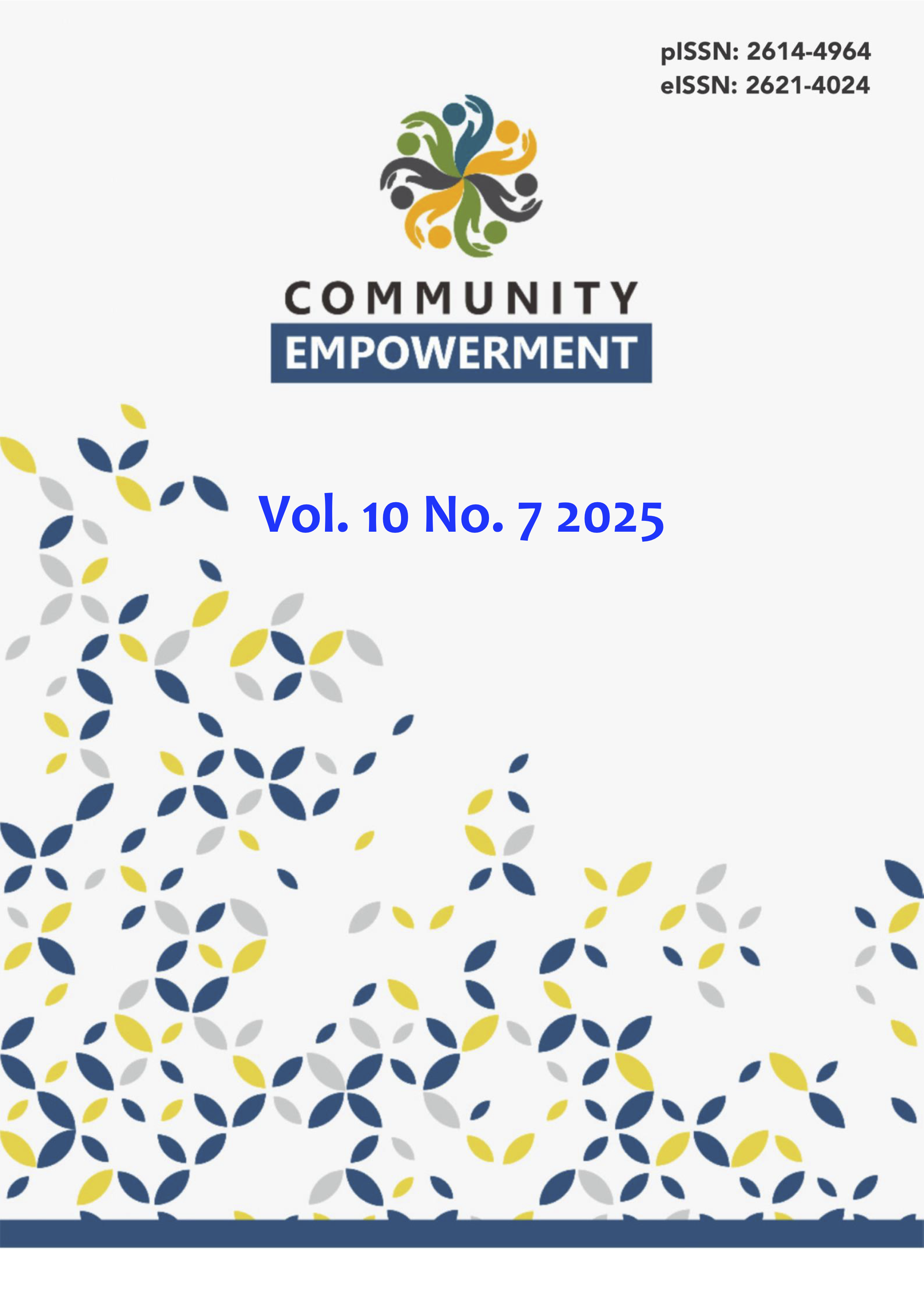Main Article Content
Abstract
In the era of globalization, English proficiency is a crucial skill for enhancing individual competitiveness. Adolescence is an ideal stage for language acquisition due to more mature cognitive abilities. This community service program was designed to address the lack of English language learning at the Pondok Pesantren Rahmatullah Lempake in Samarinda, a problem primarily caused by limited teaching staff. The main goal of this activity was to equip students with foundational English knowledge, empowering them to become more competitive and competent individuals in society. The program, conducted over 12 meetings, provided basic English instruction to 9th-grade Wustho students. The methodology included a preparation stage, followed by implementation using the service-learning method, and concluded with a comprehensive evaluation. The evaluation results demonstrated a notable improvement in both understanding and motivation among the participants. Specifically, the students' basic English language skills showed an increase of 60-80%, highlighting the program's effectiveness in bridging the educational gap and fostering a positive learning environment.
Keywords
Article Details

This work is licensed under a Creative Commons Attribution-NonCommercial 4.0 International License.
References
- Biemiller, A., & Boote, C. (2006). An effective method for building meaning vocabulary in primary grades. Journal of Educational Psychology, 98(1), 44–62. https://doi.org/10.1037/0022-0663.98.1.44
- Cenoz, J., & Gorter, D. (2020). Teaching English through pedagogical translanguaging. World Englishes, 39(2), 300–311. https://doi.org/10.1111/weng.12462
- Dehghanzadeh, H., Fardanesh, H., Hatami, J., Talaee, E., & Noroozi, O. (2021). Using gamification to support learning English as a second language: a systematic review. Computer Assisted Language Learning, 34(7), 934–957. https://doi.org/10.1080/09588221.2019.1648298
- Dörnyei, Z. (2001). Motivational Strategies in the Language Classroom. Cambridge University Press.
- Erikson, E. H. (1968). Identity: Youth and Crisis. W. W. Norton & Company.
- Getie, A. S., & Popescu, M. (2020). Factors affecting the attitudes of students towards learning English as a foreign language. Cogent Education, 7(1). https://doi.org/10.1080/2331186X.2020.1738184
- Grossman, P. L., Smagorinsky, P., & Valencia, S. (1999). Appropriating tools for teaching english: A theoretical framework for research on learning to teach. American Journal of Education, 108(1), 1–29. https://doi.org/10.1086/444230
- Han, Z. (2002). A Study of the Impact of Recasts on Tense Consistency in L2 Output. TESOL Quarterly, 36(4), 543. https://doi.org/10.2307/3588240
- Handayani, S. (2016). Pentingnya Kemampuan Berbahasa Inggris Sebagai Dalam Menyongsong ASEAN COMMUNITY 2015. Ikatan Sarjana Pendidikan Indonesia (ISPI) Jawa Tengah, 3(1), 102–106.
- Hung, H.-T. (2015). Flipping the classroom for English language learners to foster active learning. Computer Assisted Language Learning, 28(1), 81–96. https://doi.org/10.1080/09588221.2014.967701
- Ilham, Irwandi, Isnaini, Y., Rahmaniah, R., Hudri, M., & Bafadal, M. F. (2021). Pendampingan Pembelajaran Bahasa Inggris Dasar pada Santri Pondok Pesantren Nurul Islam Di Kekalik, Sekarbela, Mataram. JCES (Journal of Character Education Society), 4(4), 1051–1060.
- Javed, M., Juan, W. X., & Nazli, S. (2013). A study of students’ assessment in writing skills of the English language. International Journal of Instruction, 6(2), 129–144.
- Karimah, S. A., & Al-Nur, W. R. (2023). Introduction to the importance of learning English for early childhood and elementary schools age children in Jampang Village, Bogor. Community Empowerment, 8(5), 630–637. https://doi.org/10.31603/CE.8401
- Maduwu, B. (2016). Pentingnya Pembelajaran Bahasa Inggris di Sekolah. Majalah Ilmiah Warta Dharmawangsa, 50.
- Mandasari, B., Aminatun, D., Pustika, R., Setiawansyah, Megawaty, D. A., Ahmad, I., & Alita, D. (2022). Pendampingan Pembelajaran Bahasa Inggris bagi Siswa-Siswi SMA/MA/SMK di Desa Purworejo Lampung Tengah. Communnity Development Journal, 3(1), 322–338. https://doi.org/10.31004/cdj.v3i1.4026
- Noviaty, P. S., Lestari, E. A. P., & Trisnadewi, K. (2022). Pengaruh Kompetensi Bahasa Inggris terhadap Kinerja Pegawai. KULTURISTIK: Jurnal Bahasa Dan Budaya, 6(1), 9–17. https://doi.org/10.22225/kulturistik.6.1.3763
- Pinker, S. (1994). The Language Instinct: How the Mind Creates Language. William Morrow and Company.
- Redondo, B., Cózar-Gutiérrez, R., González-Calero, J. A., & Sánchez Ruiz, R. (2020). Integration of Augmented Reality in the Teaching of English as a Foreign Language in Early Childhood Education. Early Childhood Education Journal, 48(2), 147–155. https://doi.org/10.1007/S10643-019-00999-5
- Riani, D., Afrianto, Y., Hasnin, H. R., Kurnia, A. D., Ibn, U., & Bogor, K. (2023). Sosialisasi dan Edukasi Pentingnya Belajar Bahasa Inggris di Era Globalisasi untuk Siswa MTS Fitra Mulia di Desa Nambo. INTEGRITAS : Jurnal Pengabdian, 7(1), 100–110. https://doi.org/10.36841/integritas.v7i1.2630
- Rubin, D. L. (1992). Nonlanguage factors affecting undergraduates’ judgments of nonnative English-speaking teaching assistants. Research in Higher Education, 33(4), 511–531. https://doi.org/10.1007/BF00973770
- Sawyer, S. M., Azzopardi, P. S., Wickremarathne, D., & Patton, G. C. (2018). The age of adolescence. The Lancet Child & Adolescent Health, 2(3), 223–228. https://doi.org/10.1016/S2352-4642(18)30022-1
- Singleton, D. M., & Ryan, L. (2004). Language acquisition: the age factor.
- Van Valin, R. (1991). Functionalist linguistic theory and language acquisition. First Language, 11(31), 7–40. https://doi.org/10.1177/014272379101103102
- Warschauer, M. (2000). The Changing Global Economy and the Future of English Teaching. TESOL Quarterly, 34(3), 511. https://doi.org/10.2307/3587741
- Wijayanti, S., & Napitupulu, S. U. (2024). Improving English language skills for human resources at CV. Langgeng Jaya, Jombang. Community Empowerment, 9(1), 18–22. https://doi.org/10.31603/ce.9861
- Woodrow, L. (2006). Anxiety and speaking English as a second language. RELC Journal, 37(3), 308–328. https://doi.org/10.1177/0033688206071315
- Zhang, Y., & Liu, G. L. (2023). Examining the impacts of learner backgrounds, proficiency level, and the use of digital devices on informal digital learning of English: an explanatory mixed-method study. Computer Assisted Language Learning, 1–28. https://doi.org/10.1080/09588221.2023.2267627

